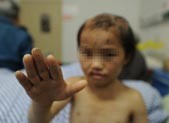
Citizens' right to education is further protected. The state has promulgated the Outline of the State Medium- and Long-term Program on Education Reform and Development (2010-2020). Since 2010 the government spending on education has been increasing rapidly. The expenditure from public finance on education increased from 1.255 trillion yuan in 2010 to 2.1165 trillion yuan in 2012. The newly added educational expenditure goes mainly to the rural areas, with 246.5 billion yuan for rural compulsory education from the central budget. The state has successively put into force a program to ensure safety of all primary and secondary school buildings across the country and a program to upgrade rural schools with poor compulsory education conditions. The state has put in place a system of assistance to students with financial difficulties, covering every schooling stage from preschool to postgraduate education, with subsidies close to 100 billion yuan every year, benefiting about 80 million students. By 2012 about 120 million rural students receiving compulsory education benefited from exemption of all tuition and miscellaneous fees as well as free textbooks, and over 13 million rural boarders from poor families received subsidies. The state has also launched a nutrition-improvement plan for rural students receiving compulsory education. By the end of 2012 the central finance allocated a special fund of 19.1 billion yuan for the plan, benefiting about 30 million students. Since 2010 the central government has invested a total of 29.7 billion yuan to support more than 10,000 schools in building or renovating facilities such as student dormitories and dining halls. The nine-year compulsory education has been implemented in all counties in China, covering all the population and benefiting 160 million students. In 2012 the number of students graduating from primary and middle schools reached 91.8 percent of the total enrollment, and the average years of schooling for people above 15 reached over nine years, surpassing the world average level; the gross enrollment ratio of senior high schools was 85 percent, equivalent to the average level of developed countries; and the higher education gross enrollment ratio was 30 percent, with the on-campus student population reaching 33.2521 million, ranking first in the world. The number of students applying for admission into universities and colleges was 9.22 million and 6.91 million were admitted, with the national average admission rate standing at 75 percent. There are altogether 139,900 non-state-run schools (educational institutions) at different levels, with an on-campus student population of 39.1101 million. There are 13.9387 million children of rural migrant workers receiving compulsory education in cities, accounting for 9.7 percent of all the students who are receiving compulsory education, and 80.2 percent of them attend government-run schools. Different kinds of complete educational systems from preschool education to higher education have been established in areas inhabited by ethnic minorities in compact communities, and the schooling years of ethnic minorities have been markedly increased. By the end of 2012, the total number of on-campus ethnic-minority students at all levels had reached 23.8448 million, 9.27 percent of the national student population. There are 15.1546 million ethnic-minority students receiving compulsory education, with those receiving secondary education accounting for 9.39 percent of the national total and those receiving elementary education accounting for 10.7 percent of the national total.
Children and women's rights are better protected. Since 2010 the state has constantly improved laws and policies on the protection of children and women's rights. The newly amended Electoral Law of the People's Republic of China on the National People's Congress and Local People's Congresses, Organizational Law of Villagers' Committees, Regulations Concerning the Labor Protection of Female Staff and Workers and the newly formulated Social Insurance Law all pay high attention to the increase of female representativeness in politics, the promotion of maternity insurance and the creation of a safe and healthy working environment for female employees. The outline of the 12th Five-year Plan specially added two sections, i.e., "promoting women's development in an all-round way" and "giving priority to children's development." In 2011 the Chinese government issued the Outline Program for the Development of Chinese Women (2011-2020) and Outline Program for the Development of Children (2011-2020), to further implement the basic national policy of equality between men and women, and the principle of giving priority to children. The implementation of the National Plan of Action to Combat Trafficking of Women and Children (2008-2012) and the Opinions on Punishing the Crimes of Abducting and Trafficking in Women and Children further strengthened the legal protection of women and children's rights. Women's health keeps improving and their average life expectancy has been further extended. In 2010 the average life expectancy of women was 77.37 years, 4.99 years longer than men, and an increase of 4.04 years over that of 2000. Women have more job opportunities. In 2011 the number of women who were employed reached 351.53 million across the country, and over the years women account for about 46 percent of all employees. Generally, women are having wider access to social security, and the coverage of maternity insurance for urban female workers is 95 percent. Women's representativeness in politics is increasing, and their awareness of social participation is growing. At the end of 2011, there were females in 83.9 percent, 86.5 percent and 89.8 percent of the leading bodies at the provincial, city (prefectural) and county levels, respectively. Children's health is also improving. The infant mortality and mortality of children under five years old both keep declining. In 2012 the infant mortality was 1.03%, and the mortality of children under five years old was 1.32%, respectively, realizing one of the UN Millennium Development Goals ahead of schedule. The state is implementing an immunization program, and the free vaccination has been expanded from seven diseases prevented by five vaccines to 15 diseases prevented by 14 vaccines. Children's right to education is fully guaranteed. In 2011 the gross enrollment rate of kindergartens, net enrollment rate of elementary schools and gross enrollment rate of middle schools were 62.3 percent, 99.8 percent and 100.1 percent, respectively. The right of children with migrant families and disabled children to education is basically protected. The rights of vulnerable groups of children such as orphans, impoverished children, waifs and HIV-infected children are basically protected, and they are getting more care and assistance.
【11】 【12】 【13】 【14】 【15】 【16】 【17】 【18】 【19】 【20】
【21】 【22】


















 Father arrested for 'torturing' teen daughter
Father arrested for 'torturing' teen daughter


![]()
